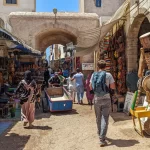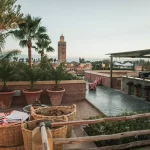When it comes to culinary delights, few destinations can rival the tempting offerings of Morocco. This vibrant country is a paradise for food lovers, captivating the senses with its vibrant colors and exotic spices. However, it is the flavour that truly reigns supreme in Moroccan cuisine. Each dish, from the humble Tagine to the ubiquitous Couscous, is an explosion of taste that will leave you craving more. If you’re seeking a culinary adventure, look no further than Morocco. Bon appétit!
Table of contents
Morocco: A Gem for Food Lovers
From a travel perspective, Morocco is an absolute gem. Year after year, it remains one of the most sought-after destinations in Africa, and for good reason! However, no trip to this North African paradise would be complete without indulging in its delectable culinary delights. The locals take pride in offering dishes that will make your taste buds sing joyfully.
Embark on a Culinary Journey
If you love experiencing different cultures through their food, make sure to try these 30 traditional Moroccan dishes on your next trip. They provide a delicious and authentic way to learn about the local customs and history. Moroccan cuisine is a delightful blend of many different cultures, with influences from Berber, Andalusian, and Mediterranean cuisines, as well as European and sub-Saharan flavours. With such diverse influences, there’s something for everyone to enjoy.
A Symphony of Flavors and Spices
Moroccan cuisine is renowned for its use of spices, similar to the culinary traditions of India. Cumin, turmeric, cinnamon, saffron, nutmeg, paprika, ginger, and fenugreek are just a few of the commonly used herbs and spices that add an extra zing to Moroccan meals. Ras el Hanout, a popular spice blend consisting of up to 40 different spices, is a testament to the richness of flavors in Moroccan dishes. With such an array of aromatic spices and fresh herbs, it’s impossible not to think of mouthwatering Moroccan cuisine when you think of flavor!
Discover Morocco’s Most Popular Dishes
A Taste of Morocco: Starters, Soups, and Salads
- Couscous:
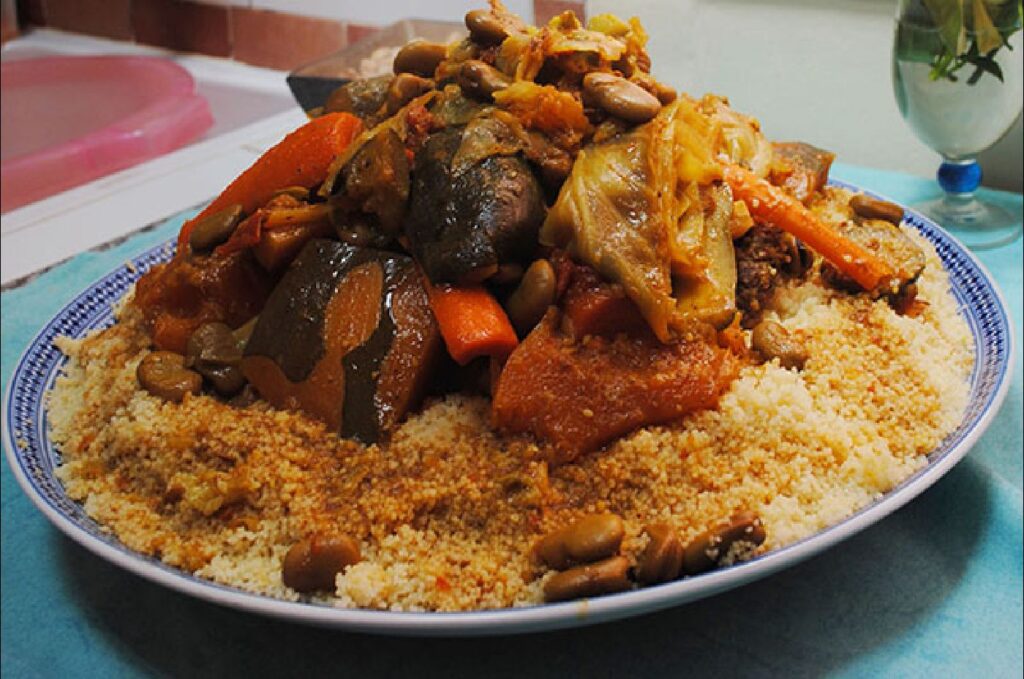
Begin your Moroccan culinary journey with the nation’s staple dish, Couscous. This widely consumed Moroccan delicacy is made from small durum wheat semolina granules. Although the traditional preparation of Couscous can be labor-intensive, the process itself is relatively quick. Traditionally, the balls are formed and left to dry in the sun before being steamed in a Couscousiere to achieve the desired consistency. Couscous is best enjoyed on a Friday, the Muslim equivalent of Sunday, when families gather for a large Couscous meal, typically served with a vegetable stew.
- Harira Soup:
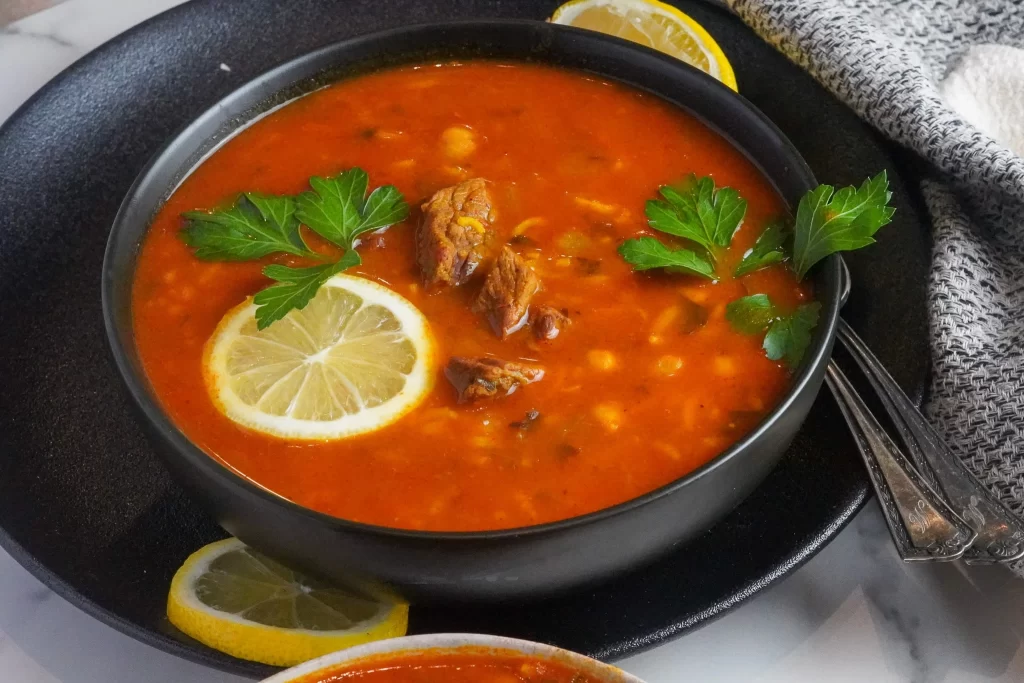
Entice your taste buds with the zesty flavors of Harira, a Moroccan-inspired soup made with lentils and chickpeas. This delicacy can be enjoyed year-round but holds particular significance during Ramadan. The soup features succulent tomatoes, hearty chickpeas, toothsome lentils, tender onions, fluffy rice, or vermicelli noodles combined with eggs for a velvety touch. Common seasonings include turmeric cilantro, parsley, cinnamon, and ginger.
- Bissara:
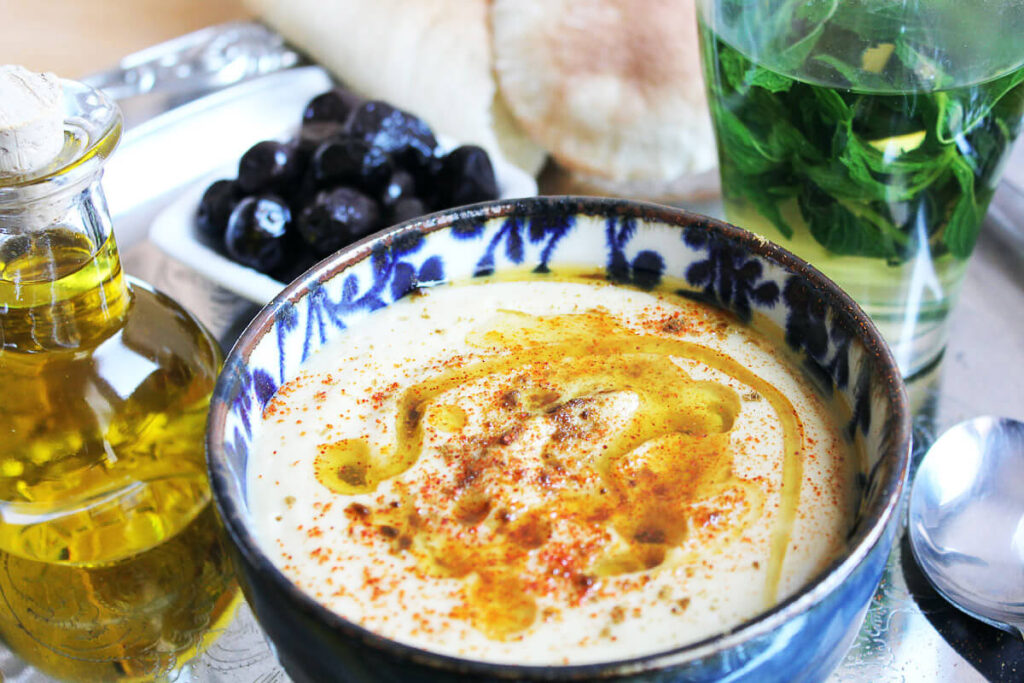
Warm up during the winter months with Bissara, a thick and hearty soup or dip made from split fava beans or peas. Seasoned with cumin, garlic, cayenne, paprika, pepper, and olive oil, it can be enjoyed as a soup or a dip with crusty Moroccan Bread.
- Shakshuka:
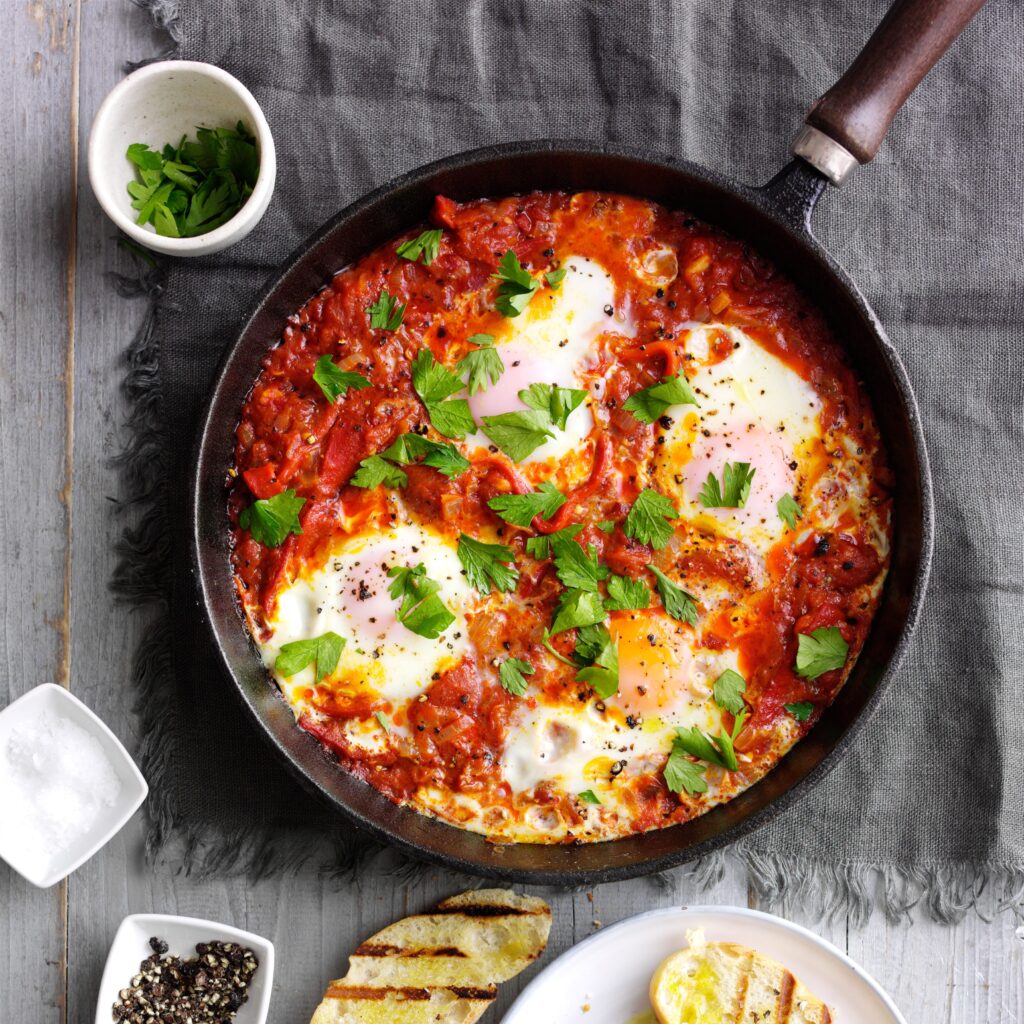
Indulge in the flavors of Shakshuka, a Mediterranean breakfast dish featuring poached eggs cooked in a flavorful tomato sauce with garlic, peppers, onions, olive oil, and spices. This versatile one-pan dish can be customized to your liking, with additions like preserved lemon, sheep milk cheese, olives, Harissa, sausage, or minced lamb.
- Taktouka:
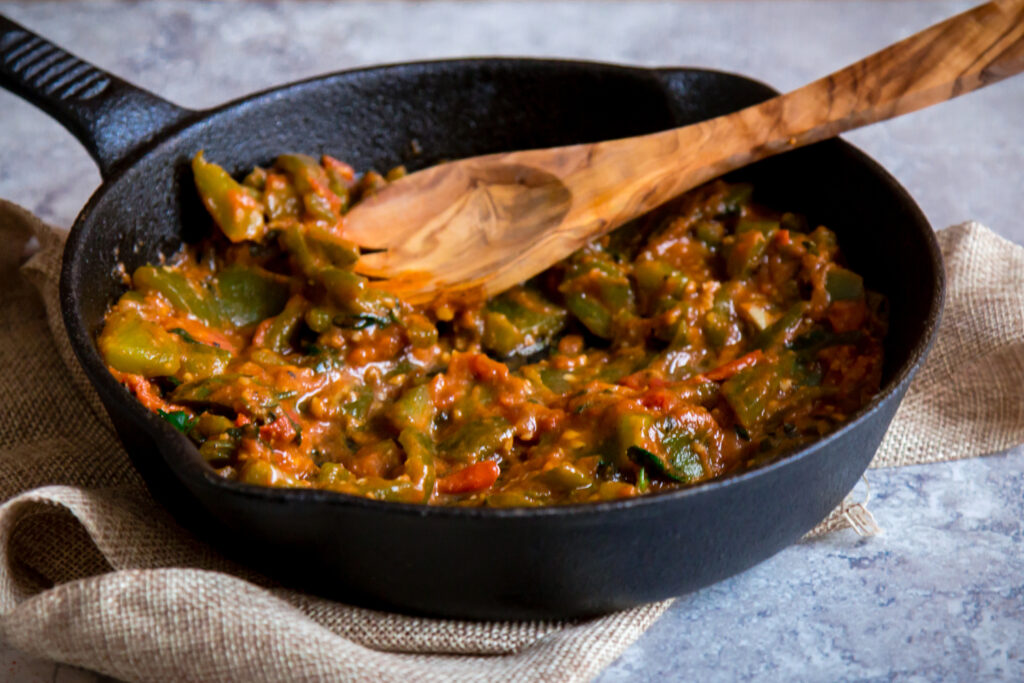
Savor the milder flavors of Taktouka, a Moroccan salad made with tomatoes, roasted peppers, olive oil, paprika, and fresh parsley. It is the perfect side dish for grilled meats or fish or can be enjoyed as an appetizer with freshly baked Bread.
- Zaalouk:
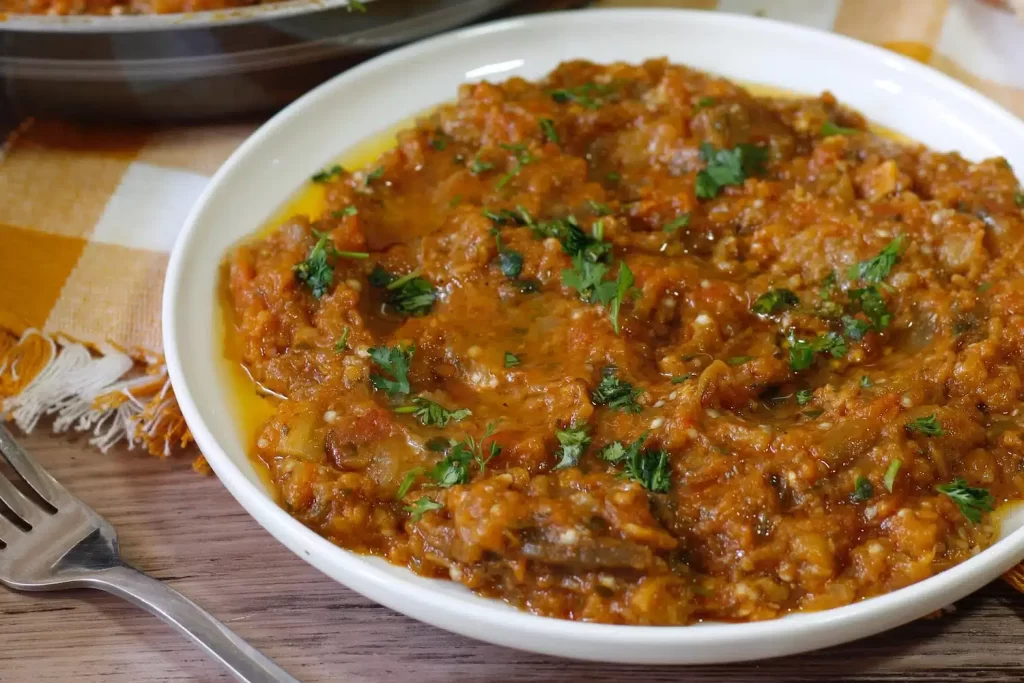
Delight in the unique flavors of Zaalouk, a Moroccan dip made from eggplant, tomatoes, garlic, olive oil, and spices such as paprika, parsley,cilantro, and cumin, paprika, parsley, and cilantro. The dish is best made with roasted eggplant, adding a smoky dimension to its taste.
- Maakouda:
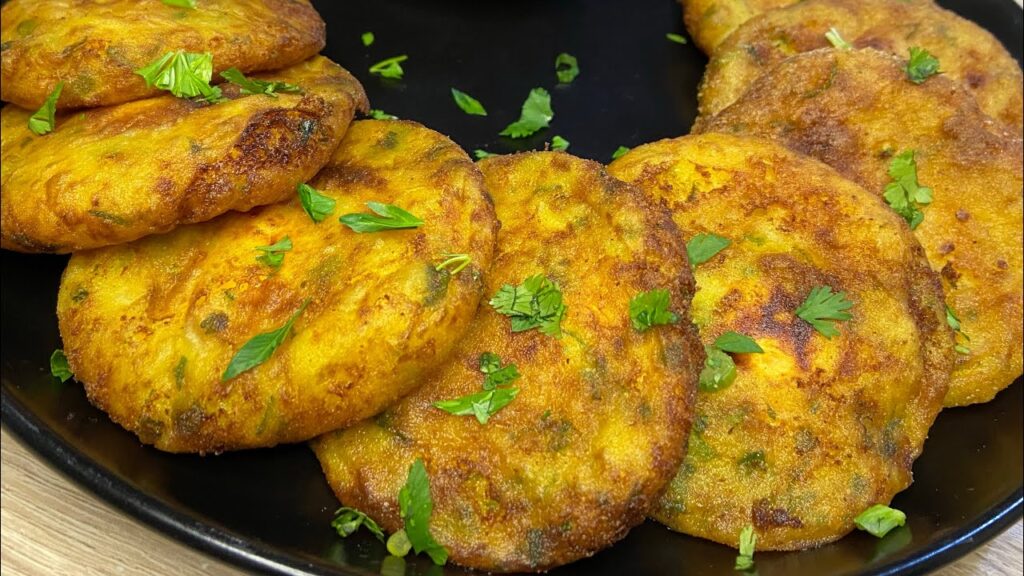
Treat yourself to Maakouda, a delicious potato patty made with fried mashed potatoes, sautéed onions, cilantro, garlic, and cumin. This versatile dish can be enjoyed as an appetizer, a side dish, or a sandwich filling, and it is particularly popular during Ramadan.
- Briouates:
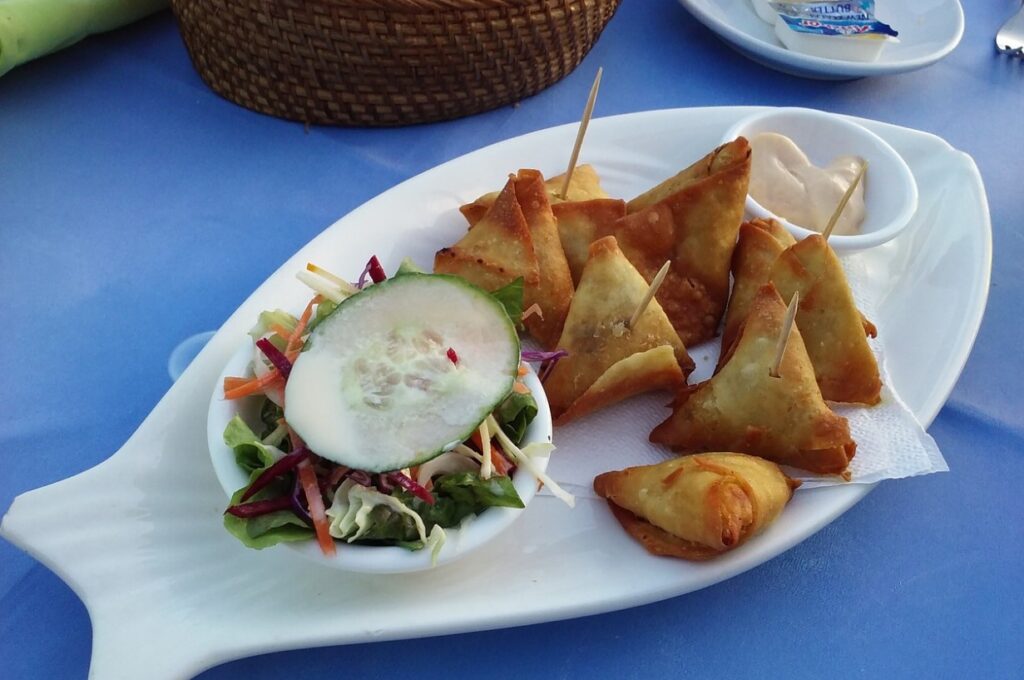
Delight in the enchanting flavors of Briouates, delicate pastries made with Warqa pastry. Whether fried or baked to golden perfection, they come in sweet and savory varieties, making them the ideal treat for any occasion.
- Khobz (Moroccan Bread):
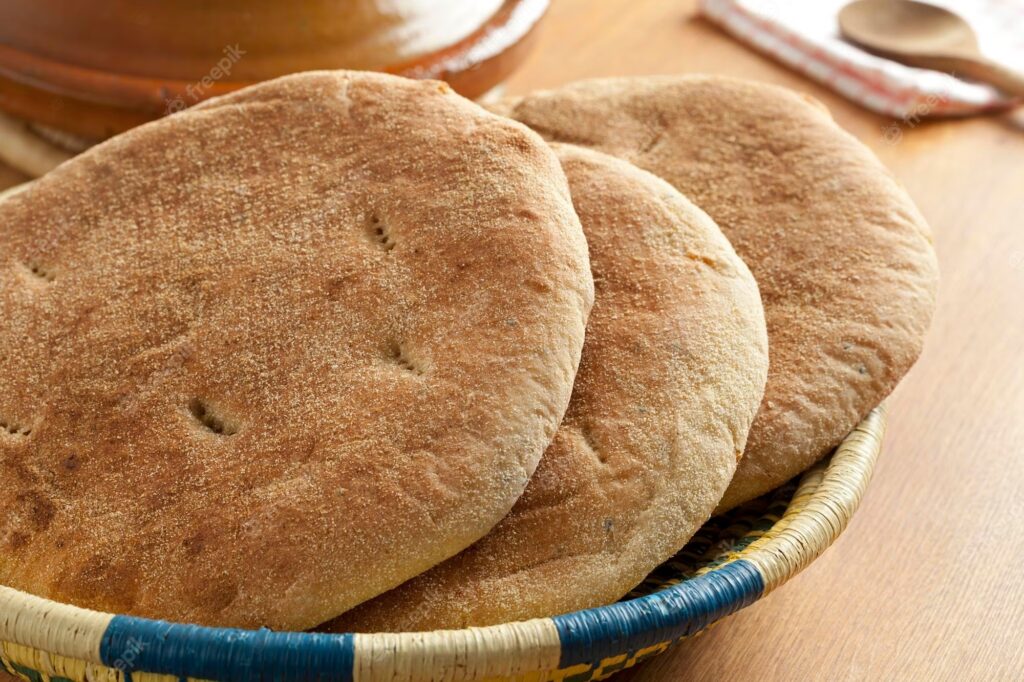
Bread is an essential part of Moroccan cuisine and culture. Khobz is a round-shaped, crunchy, and slightly rough Bread made from white flour. It is versatile and can be accompanied by a variety of Moroccan dishes, used as a scooping tool, or as a vessel for grilled meats and fillings.
- Batbout:
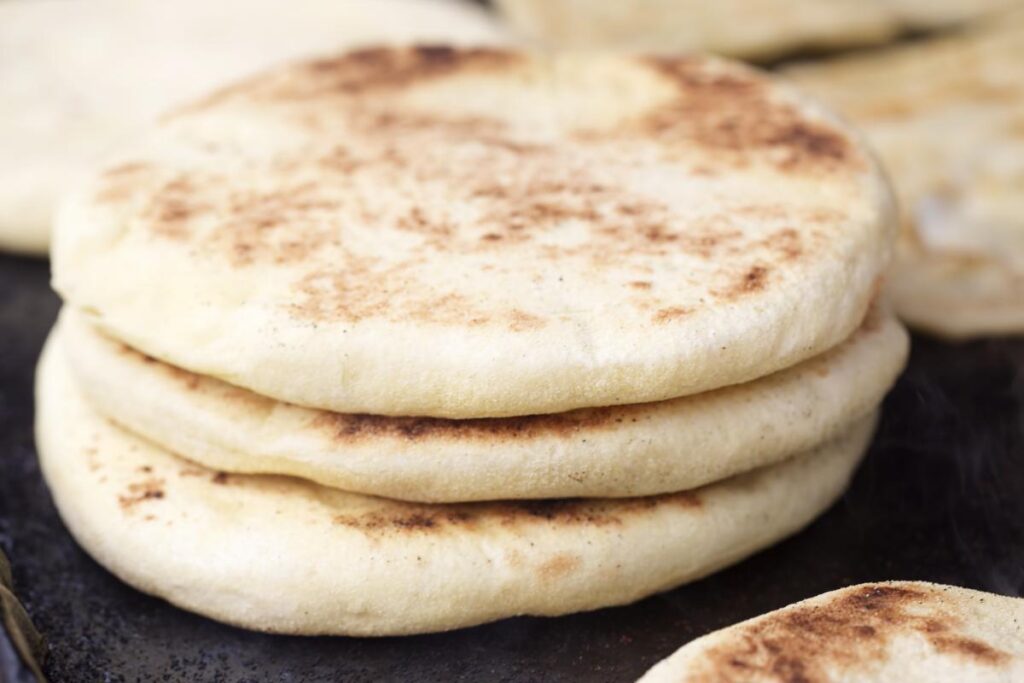
Batbout is a Moroccan flatbread made with white flour, semolina, and whole wheat flour. It is cooked on a stovetop instead of being baked, resulting in a healthier option with a unique flavor. Batbout can be shaped into different forms and is perfect for sandwiches or as a breakfast bread with butter, honey, or jam.
- Msemen:
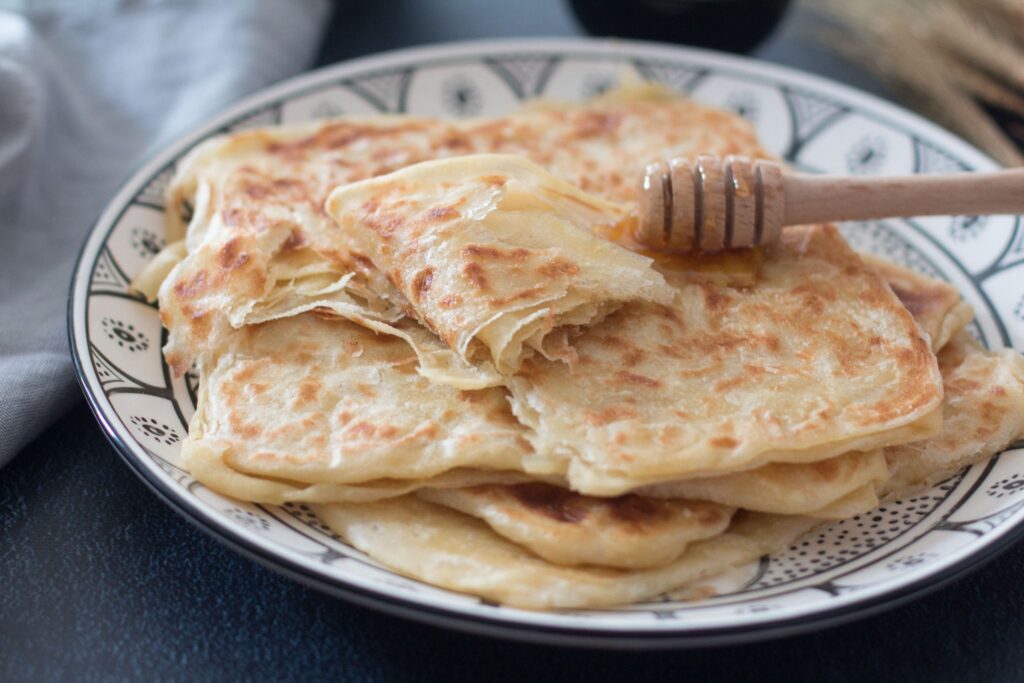
Similar to crepes or pancakes, Msemen is a thin, multi-layered flatbread enjoyed in Morocco, Tunisia, and Algeria. Made from a mixture of flour, semolina, butter, yeast, and spices, Msemen is rolled into thin disks and cooked in a skillet until golden brown. It can be served sweet with honey and butter or savory with various fillings like ground meat, onions, herbs, and spices.
- Meloui:
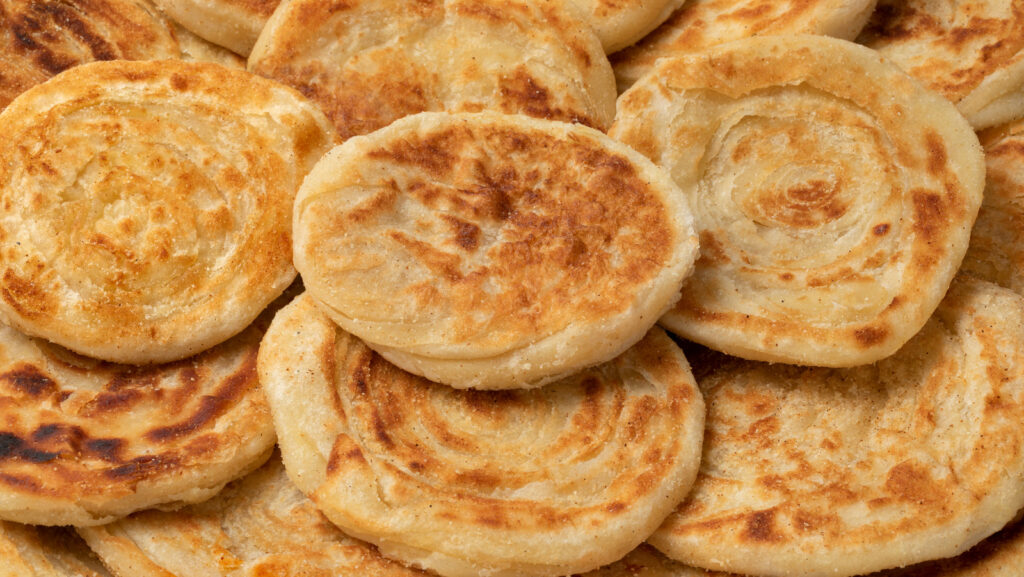
Meloui is a Moroccan pancake or crepe that is unique in shape. Unlike Msemen, which is square-shaped, Meloui is rolled into a roll before being flattened and cooked. It is made from a similar dough, including flour, semolina, butter, and orange blossom water. Meloui is typically served for breakfast or as a snack with tea.
- Baghrir:
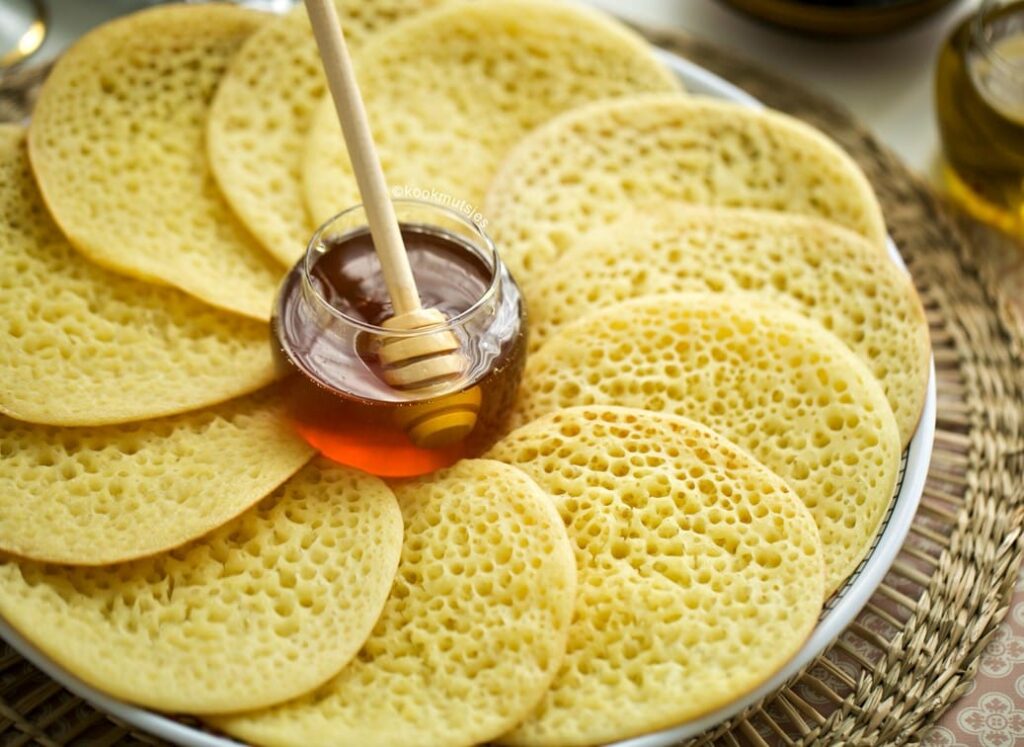
Baghrir, also known as Moroccan pancakes, are small, spongy cakes with numerous tiny holes on the surface. These holes give Baghrir its distinct texture. Made from a batter of flour, semolina, baking powder, yeast, and water, Baghrir is cooked on one side only and served with honey-butter syrup. It is a popular breakfast option and a common treat during Ramadan.
- Moufleta:
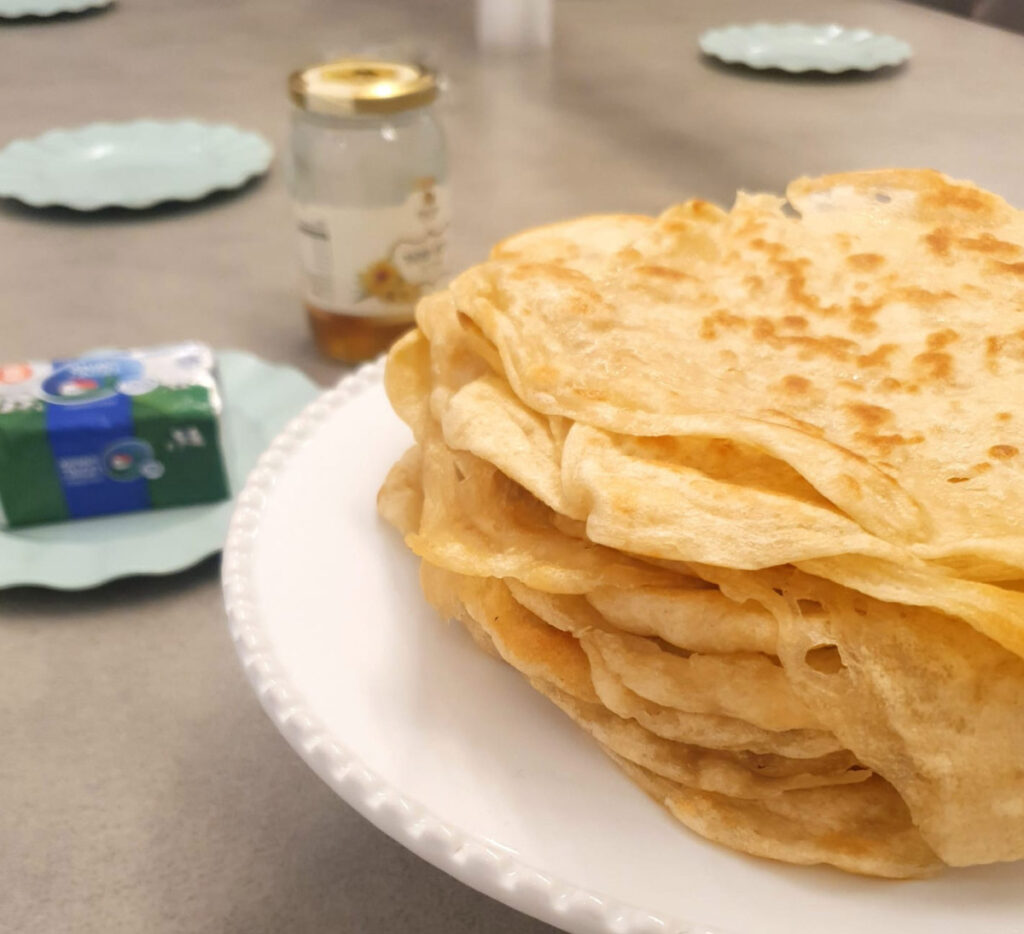
Moufleta is a traditional Moroccan Jewish pancake often enjoyed during the Mimouna celebration, which follows Passover. Made from flour, water, oil, and sometimes yeast, Moufleta is served hot with sweet accompaniments like butter, honey, or syrup, along with crunchy nuts and dried fruits.
- Harcha:
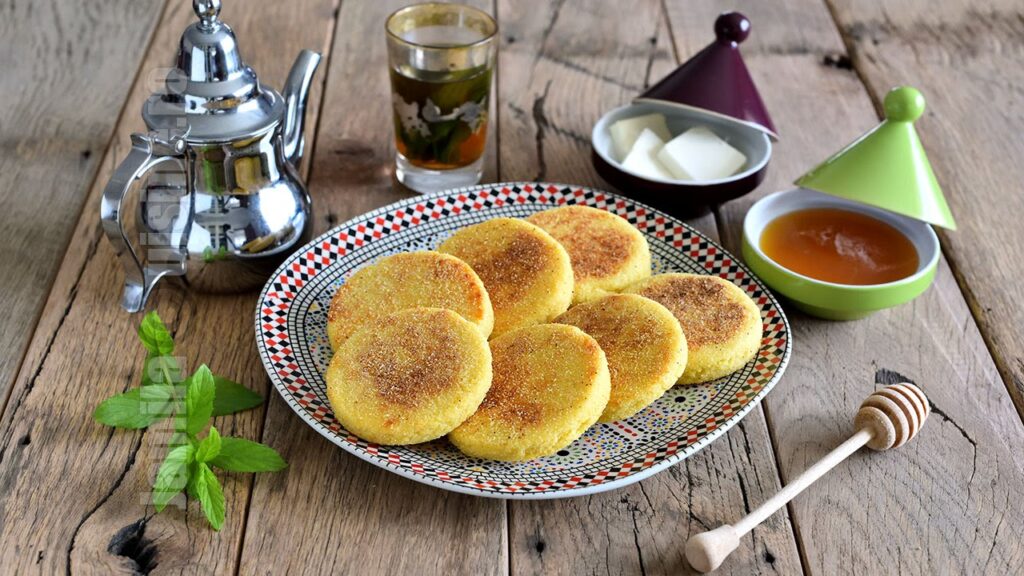
Harcha is a pan-fried bread made with semolina. It has a coarse and crispy exterior while remaining soft and flavorful on the inside. Harcha is made from a dough of semolina, butter, milk, salt, sugar, and baking powder. It is shaped into balls, rolled in coarse semolina, and cooked on a grill until golden brown. Harcha can be enjoyed for breakfast or as a snack with mint tea, jam, cheese, or honey.
- Krachel:
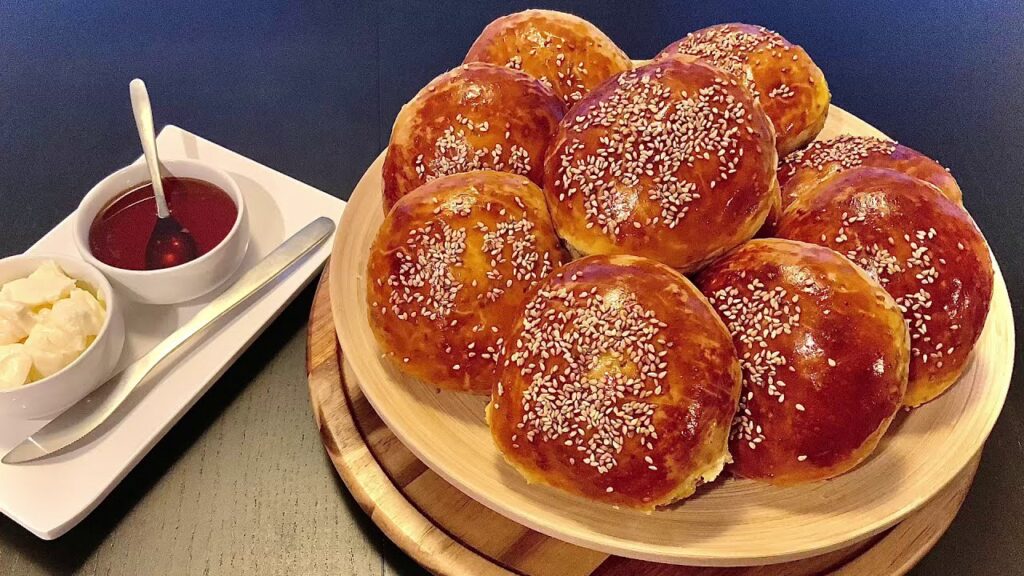
Krachel is a popular Moroccan sweet bun often enjoyed for breakfast. These fragrant buns are made from a yeast-based dough infused with aniseed and orange blossom water. They are brushed with an egg wash, dusted with sesame seeds, and baked until deeply golden. Krachel is a delightful treat to start your day with.
Exquisite Moroccan Delights: meat, seafood and poultry
Savor Moroccan Breads and Pancakes
- Tagine:
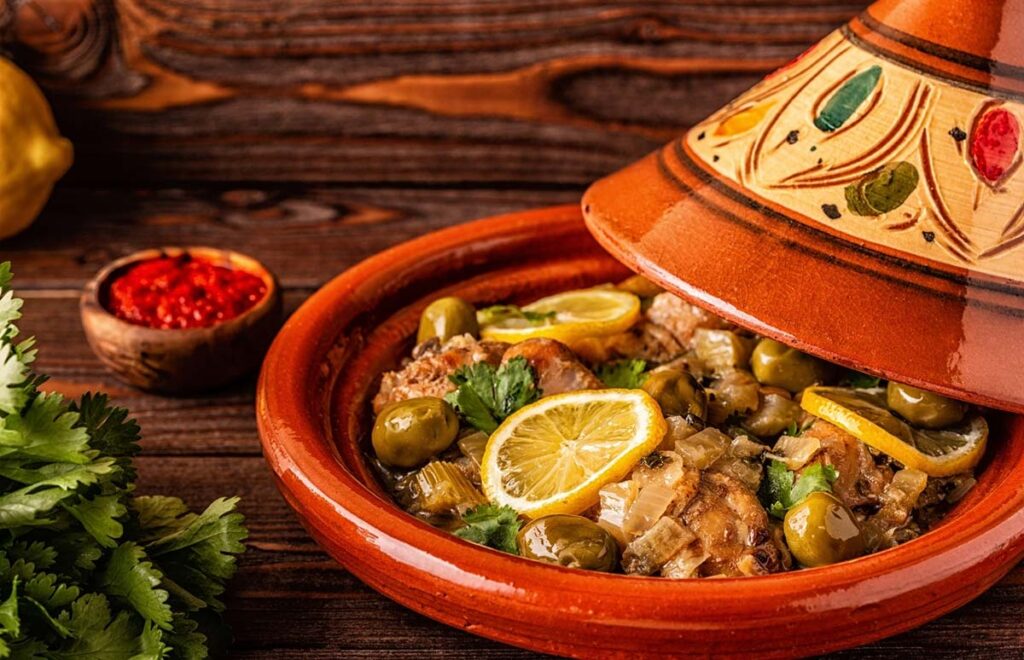
Tagine In Moroccan cuisine, the Tagine is a culinary gem that stands alongside Couscous. It refers to both the savory Berber dish and its iconic cooking vessel, known as a “Tajin” in the local language, meaning “shallow earthen pot.” This versatile creation is an exceptional addition to any meal.
The Tagine consists of two essential components: a flat, round base for cooking and serving, and its characteristic conical lid. It comes in various sizes and can be found with or without glazing. Chefs often prefer unglazed tagines for their ability to infuse dishes with earthy flavors.
The distinctive cone-like shape of the Tagine is designed to create steam and retain moisture while cooking meat, resulting in tender and flavorful dishes. This method saves water compared to traditional simmering techniques for tougher cuts of meat. Not only does it preserve the juiciness and tenderness of the protein, but it also demonstrates resourcefulness in areas with limited water supply.
Tagines are perfect for slow-cooking Moroccan stews that feature a variety of meats, poultry, fish, vegetables, and fruit. The unique shape allows for even heat distribution, resulting in succulent and tender creations bursting with flavor. Popular spices used in tagines include turmeric, saffron, paprika, cumin, cinnamon, and ginger, which contribute to the distinct sweet and sour profile. Fresh herbs, olives, preserved lemon, nuts, and dried fruit are often added to further enhance the taste and create memorable meals.
One renowned Tagine is the Kefta tagine, a celebrated dish made with spiced beef or lamb meatballs simmered in a zesty tomato sauce. Serving it alongside Moroccan Bread allows the option to poach eggs directly into this savory masterpiece!
No Moroccan culinary experience would be complete without trying a tagine at least once. It is an absolute must-try dish that embodies the rich flavors and cultural heritage of Morocco.
- Kebabs:
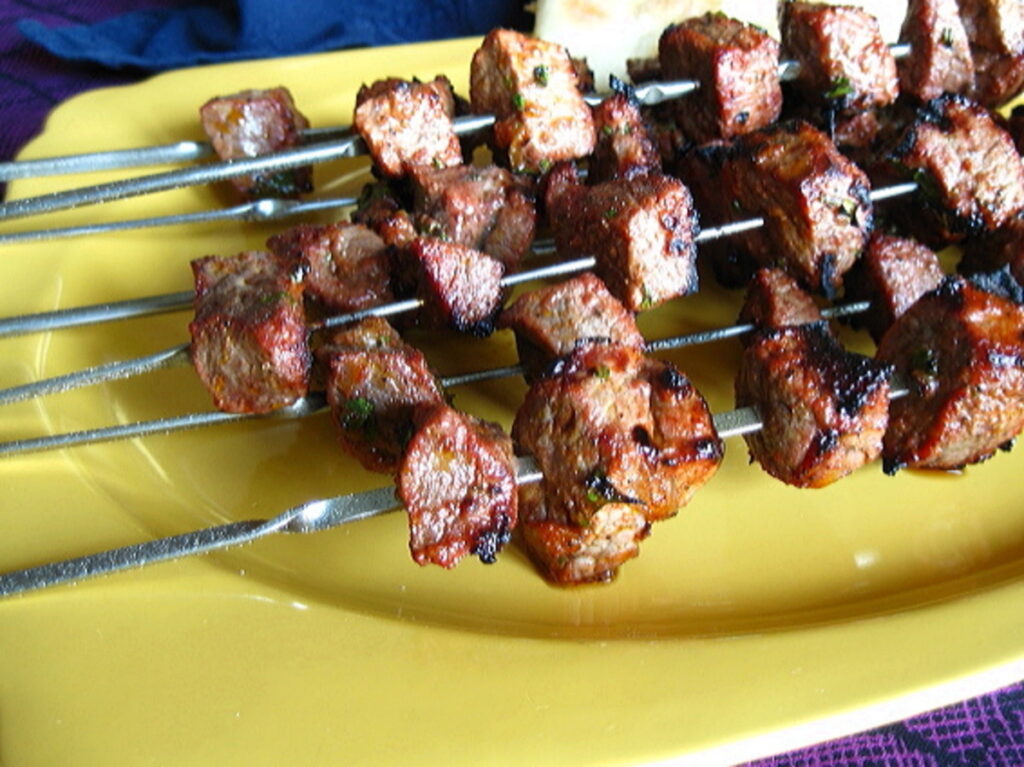
Kebabs are grilled meat skewers that are beloved in various cultures, including Morocco. The exquisite Qotban kebab features marinated lamb or beef, perfectly seasoned with onions, parsley, olive oil, and spices like salt and pepper. Cubes of fat are interspersed between chunks of protein on each skewer before they are cooked over a hot charcoal fire. When crafted with savory minced beef or lamb, these delicacies are known as Kefta (or kofta) kebabs.
- Bastilla:
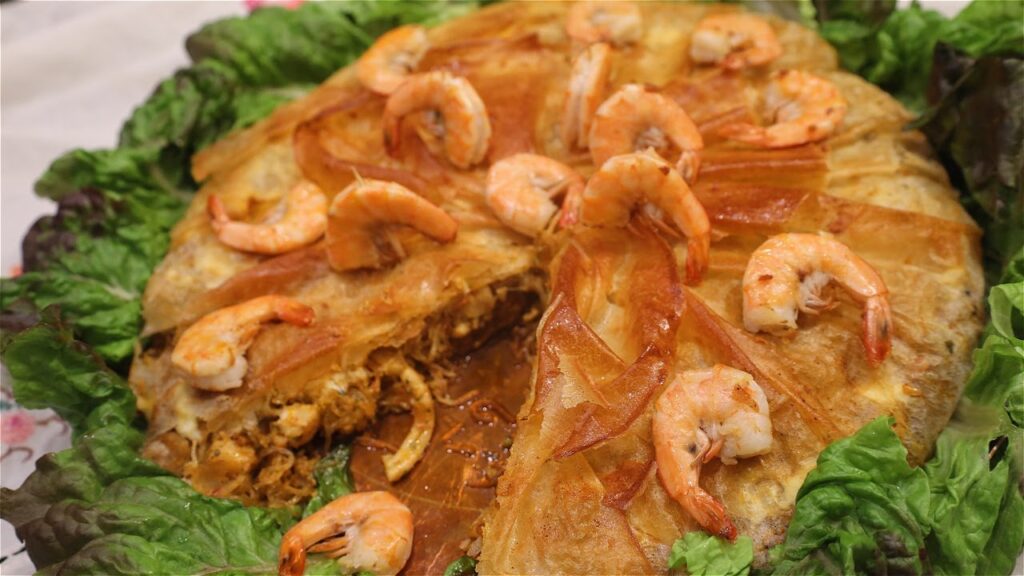
Bastilla is a delectable and popular dish in Moroccan cuisine. It refers to a savory pie made with light and crispy warqa dough. The pie can be filled with either poultry or seafood and has its origins in Andalusia. The name “Bastilla” comes from the Spanish word “pastilla,” meaning “small pastry.” This dish is a must-try for anyone who appreciates savory pies!
The aromatic Chicken Bastilla is a classic Moroccan dish that showcases culinary excellence. Tender chicken is beautifully browned in butter before being simmered with onions, parsley, and exotic spices like saffron, nutmeg, and ginger until it becomes succulent. The chicken is then deboned and shredded to create a delightful filling for this savory pastry. The reduced simmering liquid thickens with eggs to create a custard-like sauce that further enhances the dish’s deliciousness.
Delicate layers of butter-fried warqa dough are assembled in a circular skillet, alternating with the savory sauce and shredded poultry. A layer of crumbled almonds mixed with sugar and cinnamon adds an extra touch of flavor before the pie is enclosed in more layers of greased warqa pastry. The Bastilla is cooked until it achieves a delightful golden hue, and it is finally garnished with powdered sugar, cinnamon, or toasted almonds for additional sweetness before serving.
In contrast to the sweet and savory flavor combination of the chicken Bastilla, the seafood Bastilla is known for its fiery taste. This version features a blend of fish, squid, and prawns combined with vermicelli noodles and black mushrooms, all infused with an incendiary tomato sauce. Seafood Pastilla is the favorite Moroccan dish all Marrakech Desert Trips team order when we go on social gatherings at one of Marrakech restaurants.
- Chicken Rfissa:
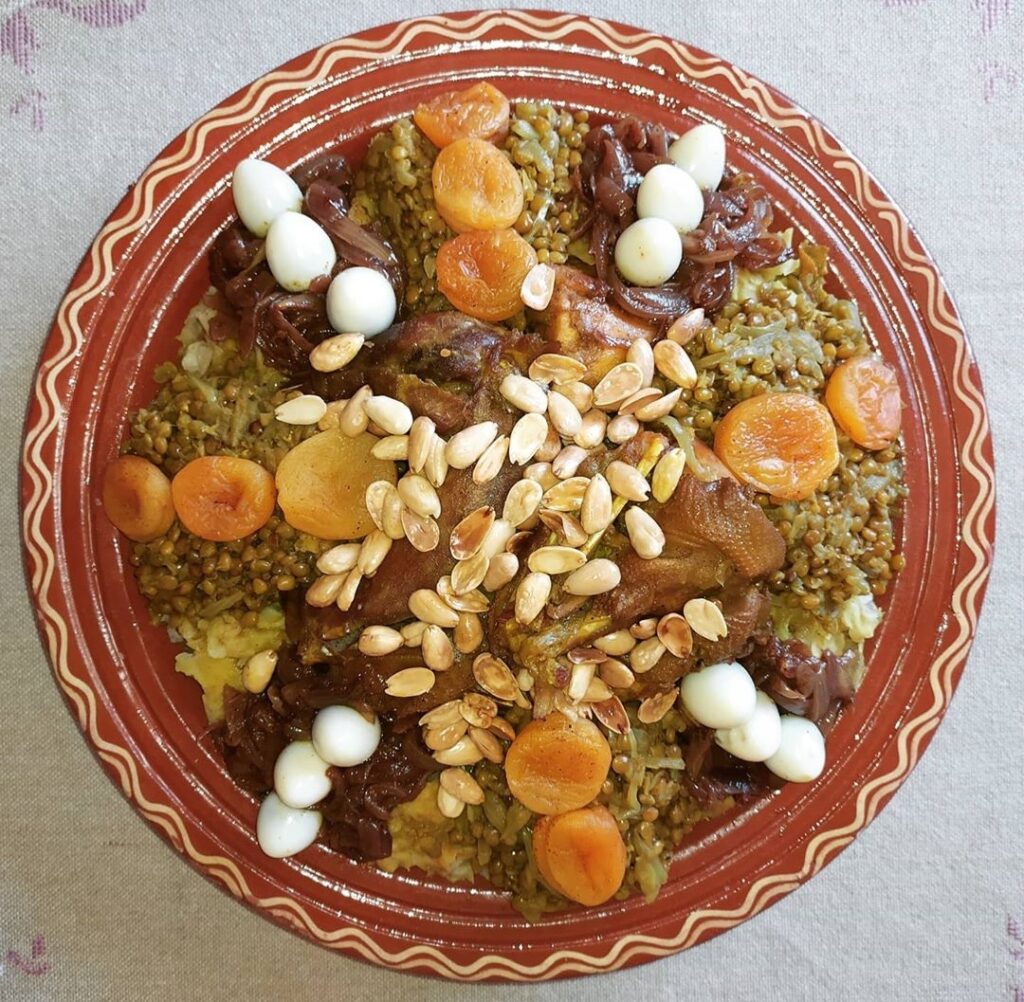
When it comes to nourishing food for new mothers, chicken Rfissa is a perfect example. This dish, made with stewed chicken, lentils, and onions served on top of shredded Trid pastry, is a popular Moroccan Berber meal given to new mothers on the third day after childbirth due to its numerous health benefits. If you’re looking for a nutritious and hearty meal to aid post-delivery recovery, look no further than chicken Rfissa!
Chicken Rfissa is a hearty and flavourful dish that is particularly comforting during chilly winters. The chicken and lentils are stewed with fenugreek seeds, Ras el Hanout, saffron, and other spices, resulting in a rich and aromatic combination. The dish is served over a bed of shredded and steamed trid pastry, adding a unique texture to each bite. It is a filling and satisfying comfort food that warms you up on cold days.
Thanks to the inclusion of fenugreek seeds, Chicken Rfissa is celebrated as a godsend for recently delivered mothers. This uncommon herb has been utilized in traditional medicine for centuries and is believed to offer numerous health advantages during the postpartum period.
Chicken Rfissa is a traditional dish prepared for new mothers, but it is also a delicious and popular meal enjoyed on other occasions and at family gatherings.
- Fish chermoula:
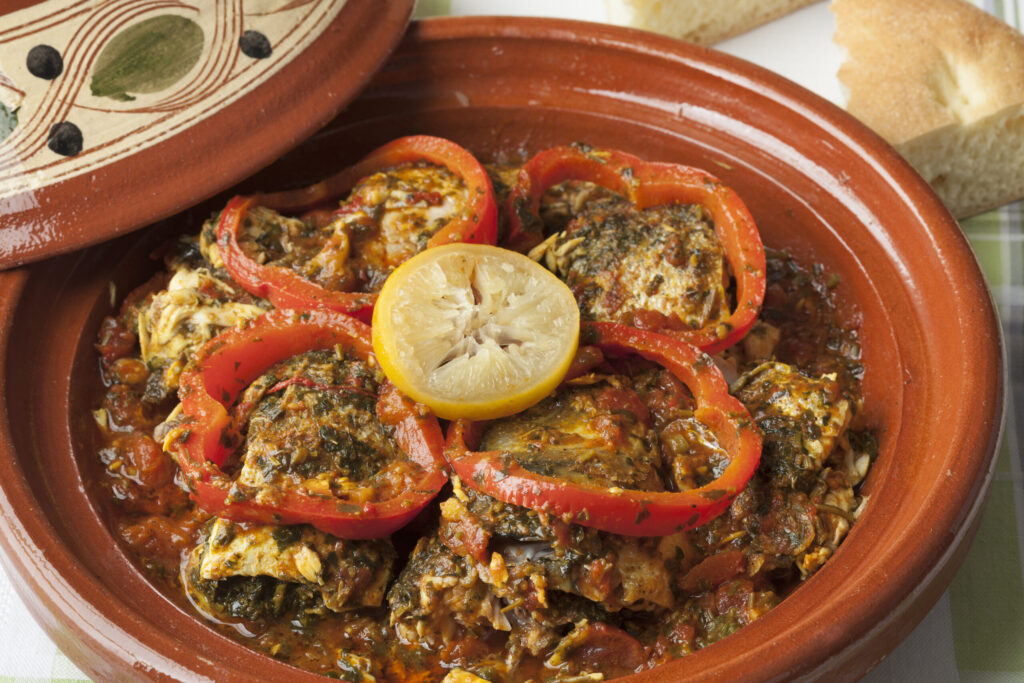
Chermoula is a fragrant and flavorful marinade or relish commonly used in North African cooking. While it is traditionally used to enhance the flavor of fish and seafood dishes, it can also be used with meats, poultry, and vegetables. Chermoula is simple to make and adds a delicious depth of flavor to any dish.
There are countless variations of chermoula, but the classic ingredients typically include garlic, salt, olive oil, fresh herbs, and spices. Depending on the region, popular additions may include black pepper, coriander, parsley, cumin, paprika, Harissa, and turmeric.
- Fried stuffed sardines:
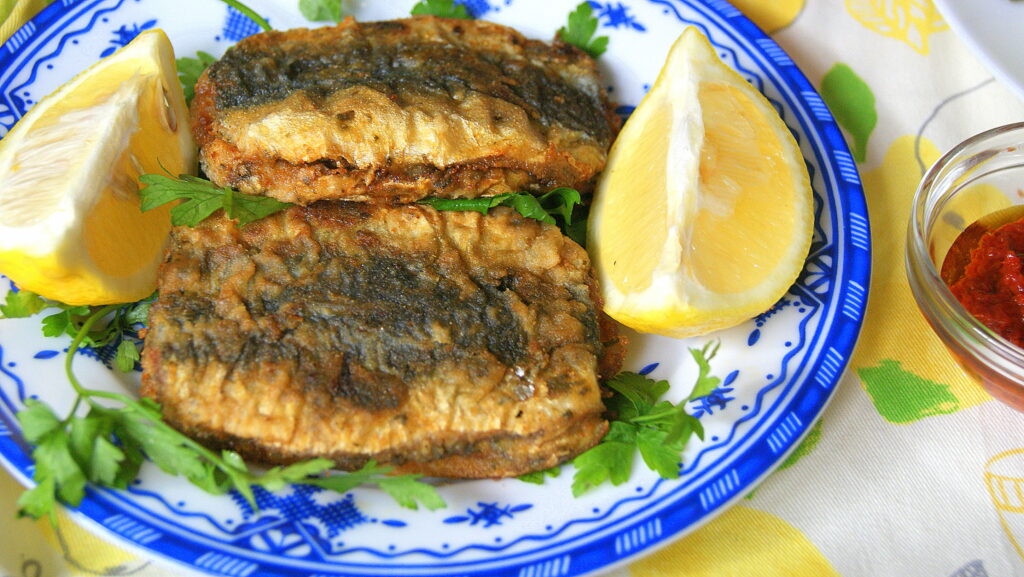
Situated on the North western coast of Africa, Morocco boasts a coastline of 3,000 km (1,864 mi), making it an ideal location for fishing and seafood production, with sardines being one of the most important catches.
Sardines caught in Moroccan waters account for over 62% of the country’s total fish catch, amounting to approximately 600,000 tons of sardines processed each year. This makes Morocco the world’s largest exporter of canned sardines.
Sardines are incredibly abundant fish, providing an inexpensive and easily accessible food source, particularly for families living in coastal areas of Morocco. Furthermore, they are a staple ingredient in many Moroccan dishes, with fried sardines stuffed with chermoula being one of the most popular preparations. When it comes to nutrition-rich and delicious seafood, it’s hard to beat sardines.
- Babbouch (Moroccan snail soup)
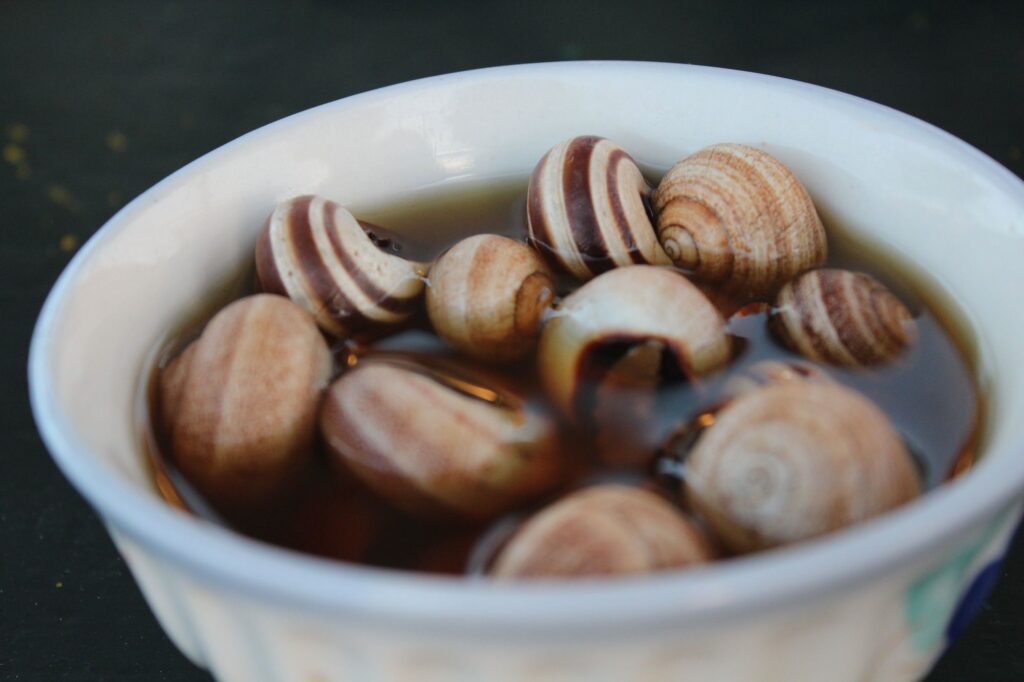
If you enjoy Vietnamese ốc, then why not try Babbouche? This delightful Moroccan street food features snails immersed in a flavorful spiced broth that is sure to tantalize your taste buds.
Recipes for Babbouche (or Ghlal) can vary greatly from vendor to vendor
Moroccan deserts and drinks
- Chebakia:
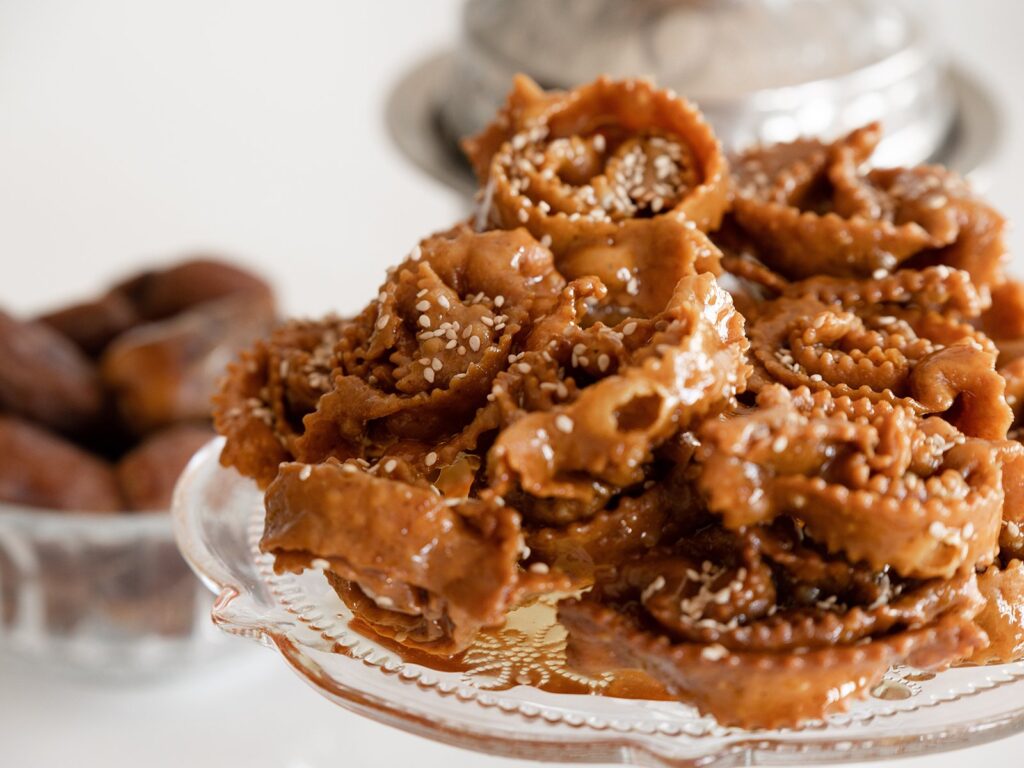
Chebakia is a traditional Moroccan sesame cookie renowned for its floral shape and crispy texture. Typically made during the month of Ramadan, it is a delightful and unique treat suitable for any occasion. The dough is prepared by rolling strips of spiced sesame dough into rose shapes, which are then deep-fried until golden brown and crunchy. After frying, the cookies are coated with a delightful honey and orange blossom syrup and sprinkled with sesame seeds. Each bite offers a satisfying crunch and a burst of flavors.
Preparing Chebakia can be time-consuming, so it is common for Moroccan women to gather and work together to make large batches, which they distribute among themselves to last throughout Ramadan. While traditionally associated with breaking the fast during Ramadan, Chebakia is also prepared for other special occasions.
- Sellou:
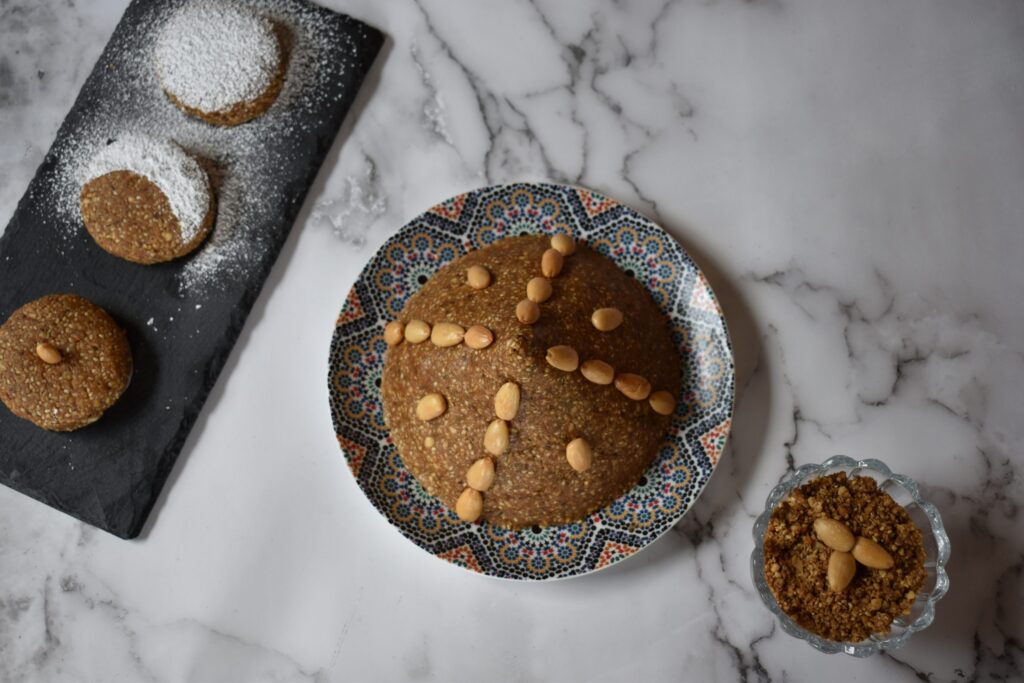
Among the dishes commonly enjoyed during Ramadan, Sellou holds a special place alongside Harira and Chebakia. This unique Moroccan dessert consists of roasted flour mixed with honey, butter, fried almonds, toasted unhulled sesame seeds, and spices.
To make Sellou, the ingredients are combined to form a thick and rich paste, which is then shaped into a pyramid and adorned with almonds. Individual portions are cut from the pyramid and served on plates.
Sellou is highly regarded for its nutritional value and high-calorie content. Nursing mothers are often advised to eat Sellou for thirty days after giving birth, as it is considered a natural dietary remedy that can help increase lactation.
- Kaab Elghzal:
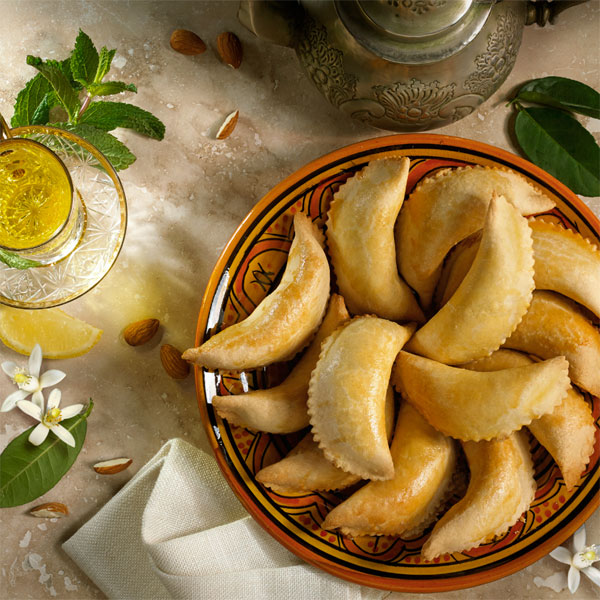
Kaab el ghazal, also known as “gazelle horns,” is a delightful pastry commonly enjoyed during Moroccan celebrations and festivals. These crescent-shaped treats are known for their buttery and melt-in-your-mouth texture. Don’t miss the opportunity to try them!
Gazelle horns are made with a white flour-based dough filled with almond paste, cinnamon, and orange blossom water. Baked to perfection and dipped in orange blossom water, these pastries are then dusted with powdered sugar, resulting in a perfectly sweet treat known as Kaab el Ghazal M’fenned.
- Ghriba
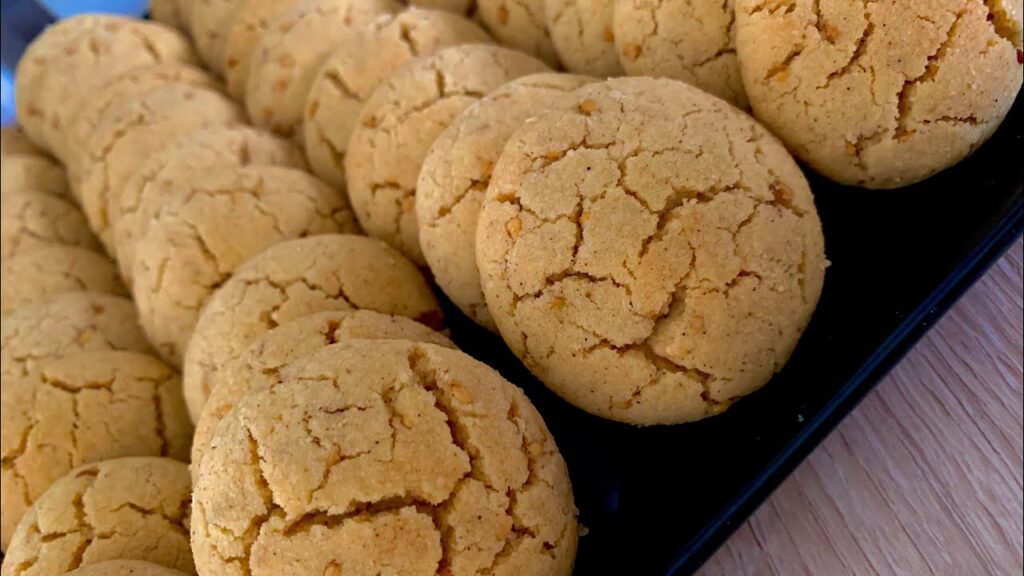
Ghriba cookies are a delicious and traditional treat in Moroccan cuisine. They are made with ground almonds and toasted sesame seeds, and come in various varieties. Ghoriba Bahla is a popular type of Ghriba known for its distinctive cracked surface. These cookies are perfect for any occasion and are sure to delight everyone who tries them!
The cracks and imperfections in Ghriba cookies are highly desirable. These fissures indicate that the cookie was made with the precise balance of ingredients, resulting in the desired texture. These cracks are essential for Ghriba, not just Ghriba Bahla.
- Kaak Essaouira:
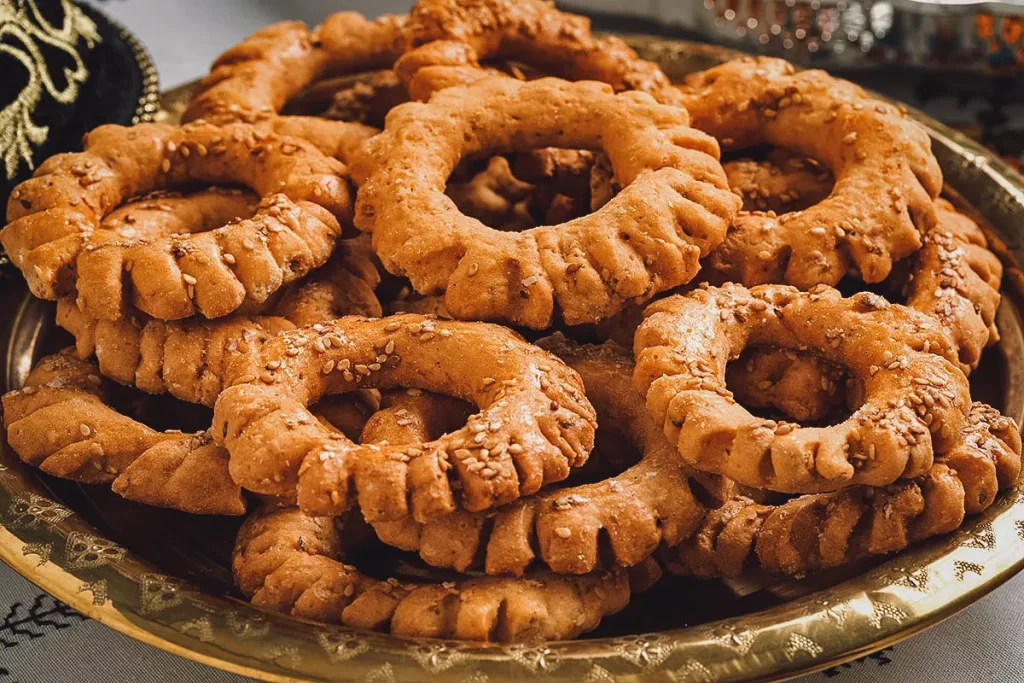
Named after the beautiful seaside city of Essaouira, Kaak d ‘Essaouira is a delightful Moroccan cookie made with flour, aniseed, sesame seeds, fragrant orange blossom water, and a delicate touch of sweetness from sugar and vanilla. Seasoned to perfection with a hint of salt, this vegan treat has gained popularity as street food throughout Morocco!
- Sfenj:
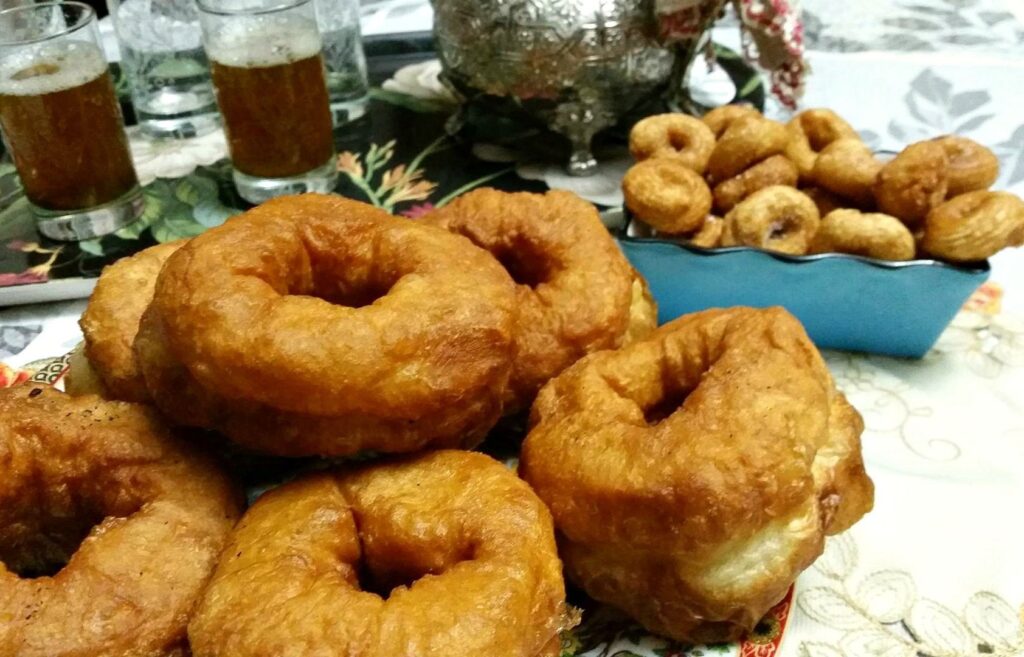
Doughnuts are a delicious and popular dessert in many cuisines, including Moroccan cuisine. Sfenj is a type of Moroccan doughnut made from sticky unsweetened leavened dough. These chewy and fluffy treats are beloved as street food in Morocco. Sfenj can be enjoyed plain, sprinkled with sugar, or dipped in honey.
Sfenj is believed to have originated in Andalusia and is rumored to have inspired French beignets. These treats have spread far and wide from North Africa, even being enjoyed by Moroccan Jews or Sephardic people during Hanukkah festivities.
Sfenj Moroccan fried doughnuts.
- Mint tea:
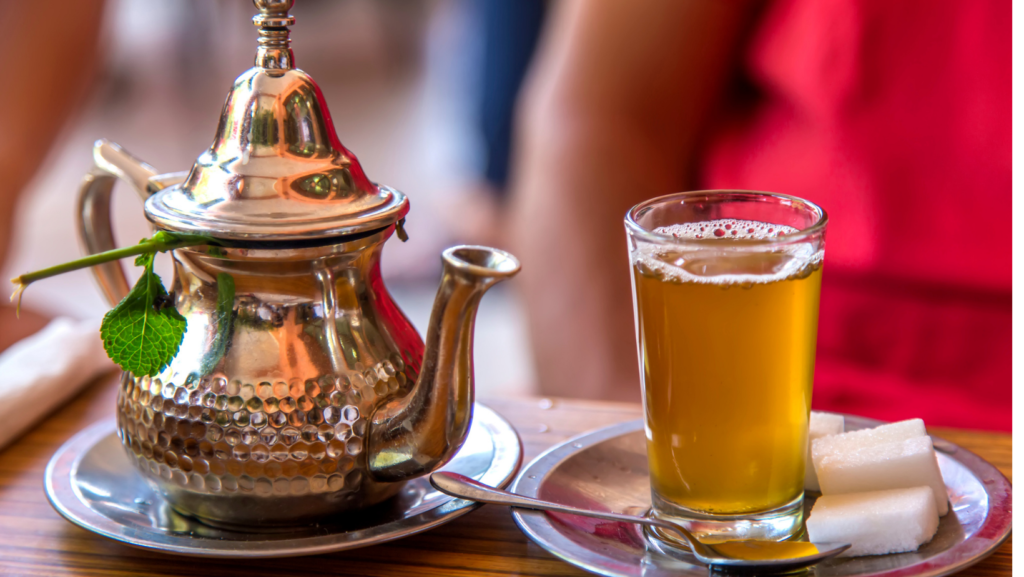
To accompany these delightful Moroccan treats, there’s nothing better than a cup of refreshing mint tea. This popular beverage is made with green leaf tea, spearmint, and sugar, and is an integral part of social life in the Maghreb region. It captures the essence of Moroccan cuisine and completes the sensory experience.
Preparing Moroccan mint tea is a ceremonial practice steeped in history. Traditionally, the head male of the family takes responsibility for making this delicious beverage and offering it to guests as a gesture of hospitality. Pouring the tea from a height creates gentle aeration, enhancing its flavor.
Mint tea is enjoyed throughout the day as a social event in Morocco. It is brewed three times and served in glasses that offer different flavors depending on the length of the steeping process.
Morocco food tours
Embarking on a Morocco desert tour is the ultimate way to experience the diverse and tantalizing flavours of Morocco. From exploring vibrant souks to discovering unique spices and immersing yourself in the medinas, a food tour allows you to savor the best of Moroccan cuisine. With knowledgeable guides by your side, you’ll learn about different dishes, ingredients, and the culinary culture of the country. Indulge in the vibrant culinary tapestry that Morocco has to offer by starting your food tour today!
Morocco cooking workshops For those eager to delve deeper into Moroccan cuisine, participating in a cooking workshop is an excellent choice. It provides an opportunity to witness the art of dish preparation firsthand, gain insights into the use of various ingredients and flavors, and enhance your understanding of Moroccan culinary traditions. Beyond learning to create mouthwatering dishes, cooking workshops are a chance to connect with fellow food enthusiasts and immerse yourself in the rich cultural heritage of Morocco. Joining a cooking class, such as the one offered at La Maison Arabe, promises an unforgettable and enriching experience centered around Moroccan food.
Final thoughts on Moroccan food
Morocco offers an immersive and exciting travel destination, captivating visitors with its bustling souks, aromatic spices, enchanting Medinas, and amazing Morocco Desert. Every sense is awakened by the vibrant blend of sights, smells, and sounds. For food enthusiasts, the unique flavours of Moroccan cuisine provide an extraordinary culinary adventure. From traditional dishes like Couscous and Tagine to sweet treats like Chebakia, Moroccan cuisine offers a diverse and captivating array of flavours. Begin your exploration of Moroccan cuisine today and unlock a world of delectable delights!



























